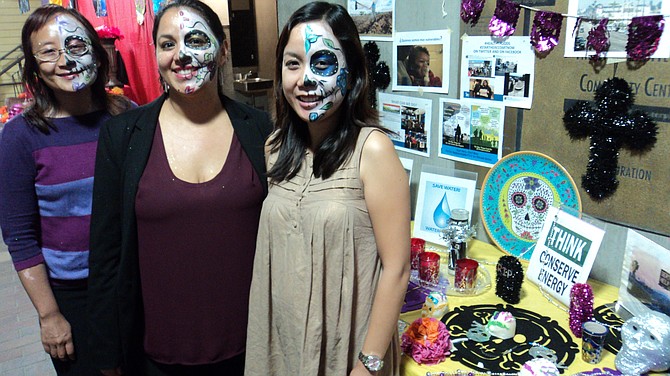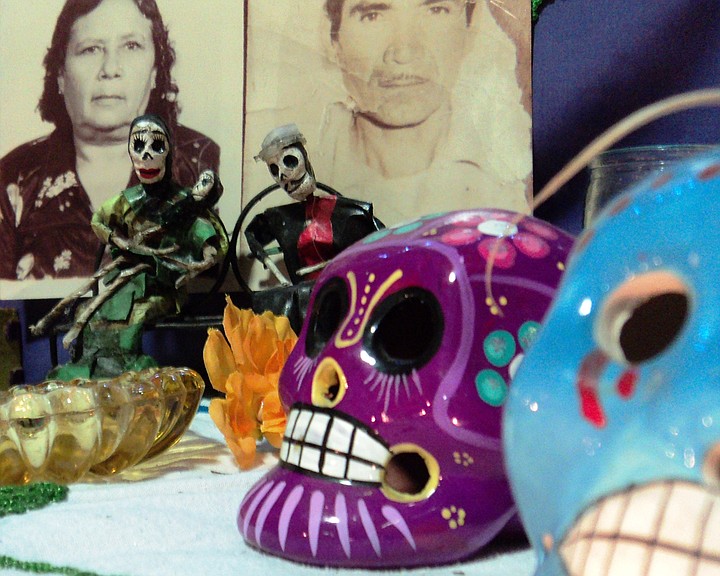 Facebook
Facebook
 X
X
 Instagram
Instagram
 TikTok
TikTok
 Youtube
Youtube

It's officially Muertos Season.
So proclaimed the Sherman Heights Community Center on October 22 concerning the Mexican celebration called Day of the Dead (Día de los Muertos). "It's our kickoff of the celebration" which is "a beautiful tradition of not being scared of death, but to honor it — that when a person dies, they never truly die," said Devonna Almagro, executive director of the center.

Almagro said many non-Mexican San Diegans have heard of the celebration but they might not know that, though the crux of the holiday is from October 31 to November 2, general observance lasts for a full month. Also, people often know few details about the traditions, such as the altars or the traditional food.
The center's "Noche de Mole" (Night of Mole) event to mark this beginning of the season featured the opening of an altar exhibition, the band Trio Ellas composed of women wearing macabre make-up singing Spanish versions of Bee Gees songs, and Mexican food with mole sauces (unique combinations of chili and chocolate) which Almagro said is the food associated with the celebration. The event coincided with the center's 21st anniversary.
"Starting Monday (October 26) we will have hundreds of students coming to the center to learn about the altars," Almagro said. The students will learn about the main aspects of the altars like the decorative perforated paper that represents the wind and the fragility of life, flowers (marigolds) that have a distinctive scent to lure the spirits of the dead, and photos of the honored ancestors. The altars always feature some food that the person enjoyed when they were alive "because they will be hungry when they come" and candles to "light the way," she said.

Some of the twenty-plus altars are very traditional, but there is one in memory of Michael Jackson and another about climate change made from recycled materials. One is based on Aztec dancers with a pyramid in the middle, and there is one in tribute to the Border Angels organization and its work to help undocumented migrants.
Almagro said besides the educational component, the altars also serve the local community. "It's part of the grieving process, and families come. The purpose is that if they don't have an altar at home, they can leave a message for a loved one here."
The center's altar exhibition runs until November 6, with a "Muertos Festival" on October 31, "Desayunos con los Muertos" (Breakfast with the Dead) on November 1 and a Muertos Procession the next day.


It's officially Muertos Season.
So proclaimed the Sherman Heights Community Center on October 22 concerning the Mexican celebration called Day of the Dead (Día de los Muertos). "It's our kickoff of the celebration" which is "a beautiful tradition of not being scared of death, but to honor it — that when a person dies, they never truly die," said Devonna Almagro, executive director of the center.

Almagro said many non-Mexican San Diegans have heard of the celebration but they might not know that, though the crux of the holiday is from October 31 to November 2, general observance lasts for a full month. Also, people often know few details about the traditions, such as the altars or the traditional food.
The center's "Noche de Mole" (Night of Mole) event to mark this beginning of the season featured the opening of an altar exhibition, the band Trio Ellas composed of women wearing macabre make-up singing Spanish versions of Bee Gees songs, and Mexican food with mole sauces (unique combinations of chili and chocolate) which Almagro said is the food associated with the celebration. The event coincided with the center's 21st anniversary.
"Starting Monday (October 26) we will have hundreds of students coming to the center to learn about the altars," Almagro said. The students will learn about the main aspects of the altars like the decorative perforated paper that represents the wind and the fragility of life, flowers (marigolds) that have a distinctive scent to lure the spirits of the dead, and photos of the honored ancestors. The altars always feature some food that the person enjoyed when they were alive "because they will be hungry when they come" and candles to "light the way," she said.

Some of the twenty-plus altars are very traditional, but there is one in memory of Michael Jackson and another about climate change made from recycled materials. One is based on Aztec dancers with a pyramid in the middle, and there is one in tribute to the Border Angels organization and its work to help undocumented migrants.
Almagro said besides the educational component, the altars also serve the local community. "It's part of the grieving process, and families come. The purpose is that if they don't have an altar at home, they can leave a message for a loved one here."
The center's altar exhibition runs until November 6, with a "Muertos Festival" on October 31, "Desayunos con los Muertos" (Breakfast with the Dead) on November 1 and a Muertos Procession the next day.
Comments